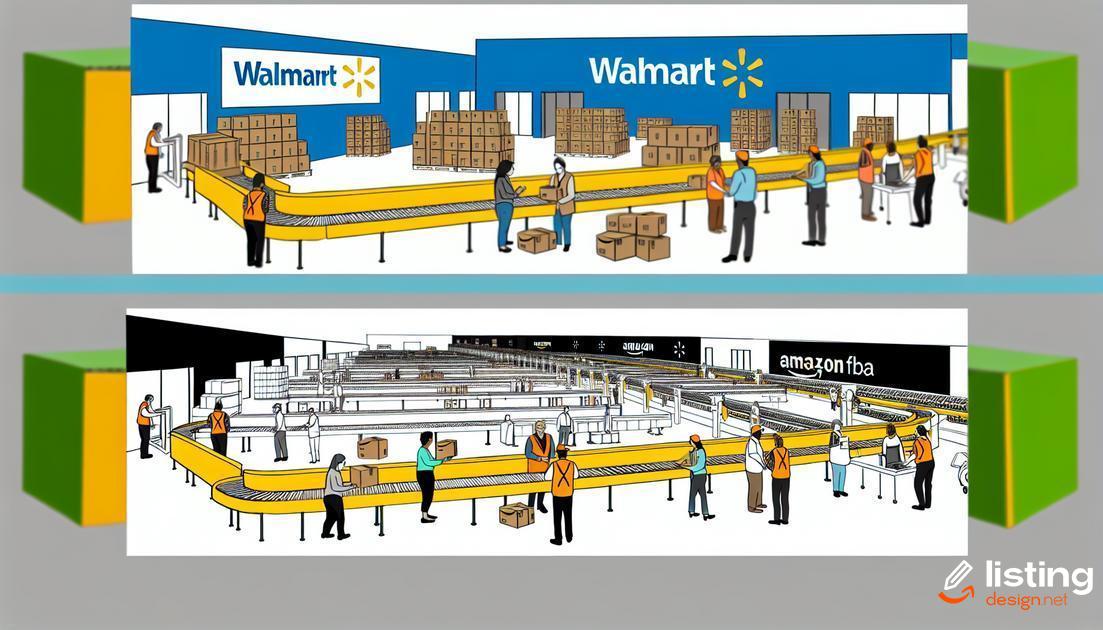When choosing a fulfillment service for your online business, comparing Walmart WFS vs Amazon FBA is essential. Both services offer unique benefits and have distinct differences. This guide will help you understand the key factors such as cost, shipping, inventory management, and customer experience to decide which service best suits your business needs.
Table of Contents
Overview of Walmart WFS
Walmart WFS (Walmart Fulfillment Services) offers a robust solution for e-commerce businesses looking to leverage Walmart’s extensive logistics network. By utilizing WFS, sellers can streamline inventory management, benefit from competitive shipping rates, and ensure fast delivery to customers.
Sellers enrolled in WFS send their products to Walmart’s warehouses, where the inventory is stored until a customer places an order. Walmart handles the pick, pack, and ship process, ensuring products are delivered efficiently. Additionally, products fulfilled by WFS are eligible for TwoDay delivery via Walmart’s advanced shipping options, which can enhance the customer experience and increase sales conversions.
Another important feature of WFS is its seamless integration with Walmart.com. This allows sellers to manage their inventory, orders, and customer service through a single platform, making it easier to maintain control over their business operations. Moreover, items fulfilled by WFS gain a ‘Fulfilled by Walmart’ tag on Walmart’s website, boosting credibility and trust among shoppers.
Walmart also provides dedicated account management and support services to help sellers navigate the WFS platform effectively, ensuring they can maximize their sales performance and overcome operational challenges swiftly. The entire service is designed to be user-friendly, helping businesses of varying sizes to scale efficiently.
Overview of Amazon FBA

Amazon FBA, or Fulfillment by Amazon, is one of the most popular services offered by Amazon for e-commerce businesses. With FBA, sellers can store their products in Amazon’s vast network of warehouses. When a customer places an order, Amazon handles the packing, shipping, and delivery. This allows businesses to leverage Amazon’s fast and reliable shipping services.
This service also includes handling returns and customer service, which can significantly reduce the operational burden on the seller. Amazon Prime eligibility is another significant advantage of using FBA, giving products higher visibility and attractiveness to Prime members.
However, fees associated with FBA can be complex. Sellers are charged for storage space and a per-unit fee for fulfillment, which can add up, especially if their inventory does not turnover quickly. Additionally, long-term storage fees can accrue for items sitting in warehouses for extended periods.
Another noteworthy feature of FBA is its Multi-Channel Fulfillment (MCF) option, which allows sellers to fulfill orders from multiple sales channels using Amazon’s logistics network. This can streamline operations for businesses selling on their websites or other platforms.
Cost Comparison
When it comes to cost comparison between Walmart WFS and Amazon FBA, understanding the various fees is crucial. Both platforms have a range of costs that can affect your overall profitability.
Walmart WFS has a simplified fee structure. It generally includes fulfillment fees based on the weight of the item and storage fees calculated monthly per cubic foot. One of the standout points for Walmart WFS is the simpler fee calculation and the potential cost savings for heavier and bulkier items when compared to Amazon FBA.
Amazon FBA, on the other hand, offers a comprehensive but sometimes more complex fee structure. This includes fulfillment fees, storage fees, and additional costs such as long-term storage fees and removal fees. Amazon FBA’s pricing can sometimes be higher, especially during peak seasons when storage fees increase. However, they also offer specialized programs like the Small and Light program to help reduce costs for smaller items.
One critical aspect to consider is the seasonal fluctuations in fees for Amazon FBA, whereas Walmart WFS tends to maintain a steadier fee structure throughout the year. Comparing these costs based on your product type and sales volume can help determine which platform provides a better overall value.
Shipping and Delivery

Shipping and Delivery can make or break your e-commerce business, especially when choosing between Walmart WFS and Amazon FBA. Both platforms offer robust shipping solutions, but they have distinct differences.
Walmart WFS (Walmart Fulfillment Services) guarantees fast and reliable delivery to your customers. Orders are shipped from Walmart’s centralized fulfillment centers, leveraging Walmart’s vast logistics network. This setup helps ensure that products reach customers quickly, enhancing customer satisfaction. Moreover, Walmart offers two-day delivery on qualified items, giving sellers a competitive edge.
On the other hand, Amazon FBA (Fulfillment by Amazon) offers a well-established shipping infrastructure known for its efficiency. Amazon’s extensive network of warehouses positioned globally means expedited shipping and even same-day delivery in some cases. FBA sellers also benefit from Amazon Prime, which promises quick and often free shipping to Prime members.
When comparing Shipping and Delivery for these two services, it’s important to consider factors like delivery speed, cost, and reliability. While Walmart WFS may offer a competitive two-day delivery service, Amazon FBA’s global reach and Prime benefits might be more appealing to sellers targeting a broader audience.
Some sellers might find that Walmart WFS helps them tap into Walmart’s loyal customer base, whereas others might prefer leveraging Amazon FBA’s established logistics and shipping capabilities. Consider your specific needs and target audience when making your choice.
Customer Service Experience
When comparing Walmart WFS and Amazon FBA on customer service experience, it’s crucial to consider how each platform interacts with both sellers and buyers.
Amazon FBA
offers a comprehensive support system that includes 24/7 customer service, handling returns, and managing customer inquiries on behalf of the sellers. This can significantly reduce the workload for sellers and enhance the overall customer experience.
In contrast,
Walmart WFS
also provides dedicated customer service, but it’s often reported to be less extensive compared to Amazon FBA. Walmart’s customer service tends to focus heavily on resolving issues related to orders placed on Walmart.com but may not have the same broad reach as Amazon’s support network. Amazon’s established reputation for swift and thorough customer service gives it a notable edge in this area.
Sellers should consider these differences when deciding between the two platforms. Reliable customer service can directly impact customer satisfaction and repeat business, making it a critical factor in the decision-making process.
Inventory Management

Inventory Management
When it comes to inventory management, both Walmart WFS and Amazon FBA offer robust solutions for businesses. Amazon FBA provides a more automated approach, using advanced algorithms to predict stock needs and manage replenishment. This allows sellers to avoid overstocking or running out of crucial items.
On the other hand, Walmart WFS also uses technology to streamline inventory management, but with a more hands-on approach. Sellers can directly oversee stock levels and receive notifications for low inventory. Walmart’s system is designed to be intuitive, helping business owners make real-time adjustments.
Both platforms offer integration with various sales channels, allowing seamless tracking of inventory across different marketplaces. However, Amazon FBA’s well-established network often means quicker updates and fewer errors in stock levels.
Choosing the best platform for inventory management depends largely on your business needs. If you prefer a fully automated system with minimal manual input, Amazon FBA might be the better choice. If you want more control and real-time notifications, Walmart WFS could be more suited to your management style.
Integration with E-commerce Platforms
Seamless integration with popular e-commerce platforms is crucial for sellers choosing between Walmart WFS and Amazon FBA. Both services offer compatibility with major platforms such as Shopify, WooCommerce, and BigCommerce. This integration allows for easy synchronization of product listings, inventory updates, and order processing, providing a streamlined experience for sellers.
Amazon FBA has a robust set of tools and APIs that facilitate integration with a wide variety of third-party applications. This interoperability ensures that sellers can efficiently manage their operations without needing extensive technical expertise. By leveraging Amazon’s mature ecosystem, sellers can automate numerous tasks, resulting in increased efficiency and reduced operational overhead.
On the other hand, Walmart WFS is continually enhancing its integration capabilities. While it may not yet match Amazon in terms of the sheer number of integrations, Walmart is dedicated to improving its platform compatibility. Many sellers appreciate the clean, user-friendly interface of Walmart’s integration tools, which simplify the process of connecting their e-commerce platforms to WFS.
Moreover, both Amazon FBA and Walmart WFS offer real-time tracking and reporting features. These tools are essential for monitoring sales performance, inventory levels, and shipping statuses, which helps sellers make informed decisions about their business strategies. By utilizing these integrations, sellers can provide better customer service and ensure timely fulfillment of orders.
Final Verdict: Walmart WFS or Amazon FBA?

Services Offered
Walmart WFS provides comprehensive services, including storage, packing, and shipping directly from its fulfillment centers. This streamlines logistics and promises faster delivery times. Amazon FBA offers similar services, but also includes customer service handling and returns processing, which can be a significant relief for sellers.
Cost Effectiveness
WFS typically has lower fees, making it attractive for businesses with tighter margins. However, the fees can vary depending on product size and weight. Amazon FBA may have higher fees, but offers more extensive service coverage and customer reach, potentially justifying the higher cost.
Reach and Market Presence
With WFS, sellers get access to Walmart’s massive customer base, which can translate into high sales volume. However, its reach is still less extensive compared to Amazon FBA, which has a global presence and a well-established market, offering greater visibility and sales opportunities.
User Experience
Sellers often find WFS easier to navigate and manage, due to Walmart’s simplified system. Amazon FBA’s platform is more complex but offers powerful tools that can provide deeper insights and analytics, aiding in strategic decision-making for businesses.
Suitability for Different Business Sizes
WFS is often favored by small to medium-sized businesses seeking cost-effective fulfillment solutions in the U.S. Amazon FBA caters to businesses of all sizes, from startups to large enterprises, thanks to its scalable services and global infrastructure.


